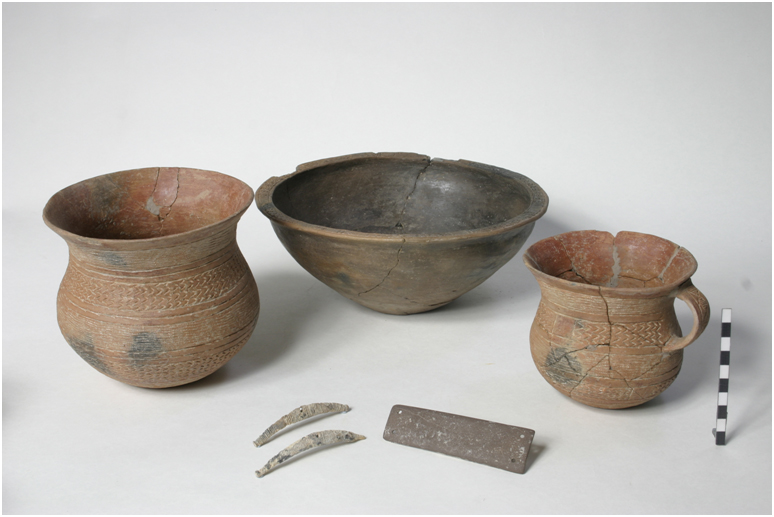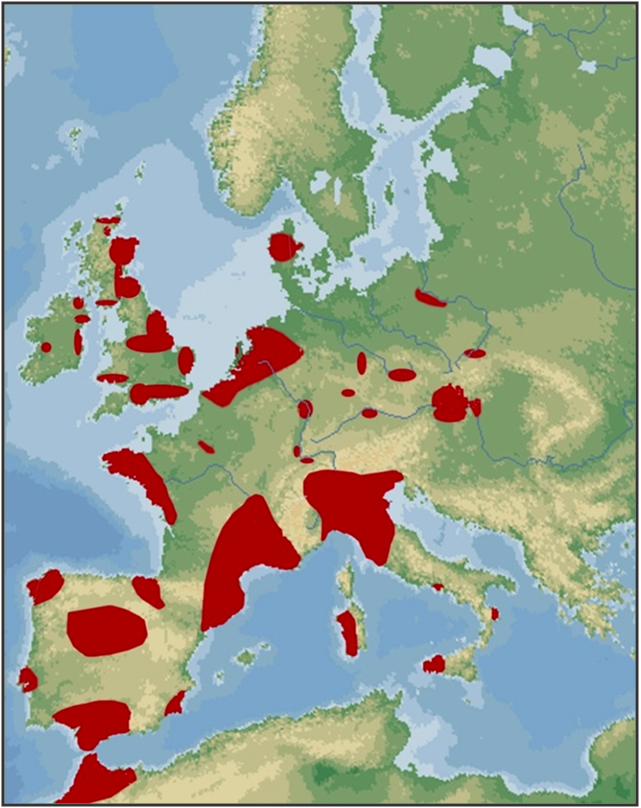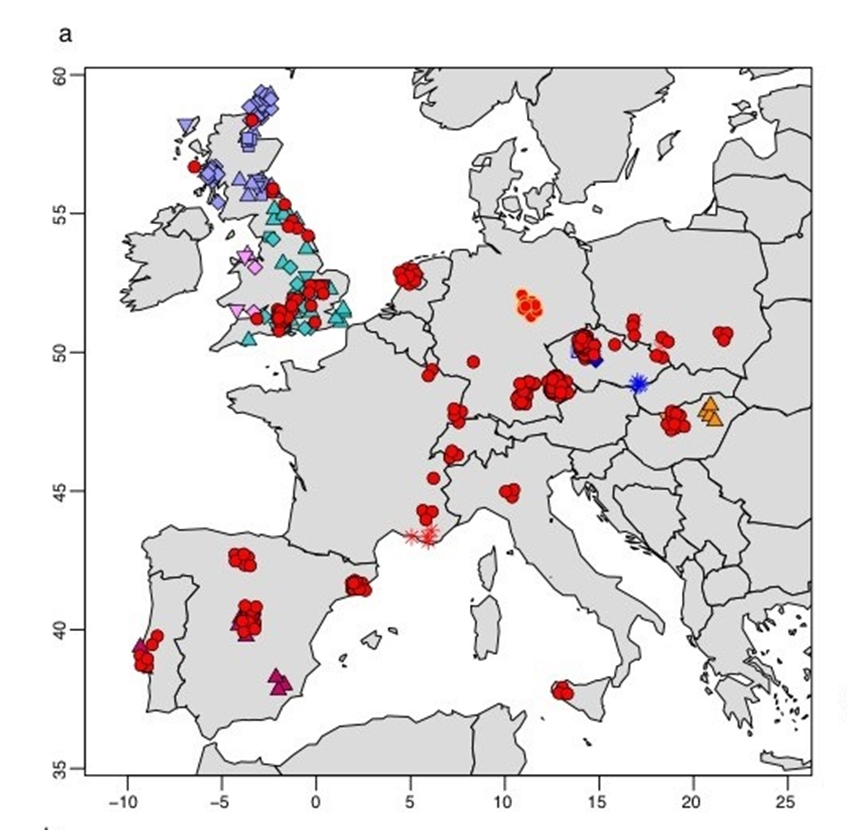Evidences of Bronze Age Mobility 3. – New results from studies of Bell Beaker population genomics published in Nature
In the largest study of ancient DNA ever conducted, an international team of scientists has revealed the complex story behind one of the oldest mysteries concerning the Bell Beaker period. The study has been published recently in the journal Nature with the co-authorship of our research team members.

Bell Beaker grave goods from Szigetszentmiklós-Felső Ürge hegyi-dűlő, Grave 146
(Source: Patay Róbert)
Migrations and Changes in Europe 4,700-4,400 years ago – understanding the Beaker phenomenon
Between 4,700-4,400 years ago, a new, bell-shaped pottery style spread across Western and Central Europe. For over a century, archaeologists have tried to establish whether the spread of “Beaker” pottery represented a large-scale migration of people or was simply due to the spread of new ideas.

Distribution of the Bell Beaker ‘culture’ in the 3rd millennium BC
(Source: Van der Linden 2007)
Now, a study that reports ancient DNA data from 400 prehistoric skeletons, drawn from sites across Europe, shows that both sides of the debate are right.

The origin of prehistoric samples analyzed in the Nature study
(Olalde et al. 2018, Figure 1a)
New customs at the frontier of Budapest
The easternmost appearance of the Beaker style pottery is the area of Budapest. Settlements and cemeteries of the era are situated along the Danube, where traces of communities from the eastern, western and southern regions of the Carpathian Basin can be traced. 13 Hungarian archeologists, anthropologists and geneticists participated in the unprecedented collaboration between most of the major ancient DNA laboratories in the world by analyzing the burials discovered at Budakalász, Békásmegyer and Szigetszentmiklós. The Institute of Archaeology (HAS RCH) and particularly its Lendület/Momentum ‘Mobility’ Research Group was also involved in the study. Genetic examination of the samples from the area around Budapest was carried out at the Laboratory of Archaeogenetics, Institute of Archaeology (HAS RCH), lead by Anna Szécsényi-Nagy.
Viktória Kiss, head of Lendület/Momentum ‘Mobility’ Research Group concluded that Bronze Age communities living in the vicinity of Budapest between 2500-2200 BC genetically consisted of not only immigrants from Western and Central Europe, but of local individuals with Neolithic/Copper Age ancestry, who certainly changed habits, as their graves were arranged according to the traditions of the newcomers.
The population of the British Isles was almost entirely replaced in prehistoric times
“On the basis of recent pan-European genomic studies, it can be stated that bell-shaped vessels have spread from the Iberian Peninsula to Central Europe without the significant migration of communities, but smaller movements could have occured, due to the various ranges of the Yamnaya heritage in the genetic profile of the investigated individuals.” – said Anna Szécsényi-Nagy. However, it is interesting to see the influence of communities of the pit-grave kurgans (Yamnaya culture) coming from the Eastern European steppe lands, on the genetic history of Western Europe. Due to the follow-up of the eastern steppe elements, the mass relocation of communities using bell-shaped vessels from the European continent to the British Isles has now been verified. The prehistoric genetic profile of the latter region has been almost unknown so far. The current research evidence suggests that the replacement of the population was highly significant, nearly 90% on the islands, and this newcomer group at the dawn of the Bronze Age could have given much of the genetic heritage of today’s Britain.

Reconstruction of male wear of the era
(Source: Landesamt für Denkmalpflege und Archäologie Sachsen-Anhalt – Landesmuseum für Vorgeschichte/Karol Schauer)
The extensive study of 107, involving many Hungarian institutions, has been the most significant achievement of the world-wide collaboration of archeogenetics, archaeologists and anthropologists so far.
Genetic samples from the 3rd millennium BC were analyzed by archaeologists, anthropologists and geneticists from the Institute of Archaeology, HAS RCH (Eszter Bánffy, Viktória Kiss, Kitti Köhler, Gabriella Kulcsár, Balázs Gusztáv Mende, Anna Szécsényi-Nagy), the Department of Anthropology, Institute of Biology, Faculty of Sciences, ELTE (Tamás Hajdu, Tamás Szeniczey), Budapest History Museum (Anna Endrődi), Ferenczy Museum of Pest county (Róbert Patay), Salisbury Ltd. (András Czene), Hungarian Natural History Museum (Zsolt Bernert), Déri Museum of Debrecen (János Dani).
References:
Olalde, I., Brace, S., Allentoft, M. E., Armit, I., Kristiansen, K., Booth, T., Rohland, N., Mallick, S., Szécsényi-Nagy, A., Mittnik, A., Altena, E., Lipson, M., Lazaridis, I., H arpens, T.K., Patterson, N. J., Broomandkhoshbacht, N., Diekmann, Y.,Faltyskova, Z., Fernandes, D. M., Ferry, M., Harney, E., de Knijff, P., Michel, M.,Oppenheimer, J., Stewardson, K., Barclay, A., Alt, K. W., Liesau, C., Ríos, P.,Blasco, C., Vega Miguel, J., Garcia, R-M., Fernández, A. A., Bánffy, E., Bernabò-Brea, M., Billoin, D., Bonsall, C., Bonsall, L., Allen, T., Büster, L., Carver, S.,Castells Navarro, L., Craig, O. E., Cook, G. T., Cunliffe, B., Denaire, A., Dinwiddy, K. E., Dodwell, N., Ernée, M., Evans, C., Kuchařík, M., Farré, J. F., Fowler, C.,Gazenbeek, M., Pena, R. G., Haber-Uriarte, M., Haduch, E., Hey, G., Jowett, N.,Knowles, T., Massy, K., Pfrengle, S., Lefranc, P., Lemercier, O., Lefebvre, A.,Martinez, C. H., Galera Olmo, V., Ramirez, A. Z., Maurandi, J. L., Majó, T.,McKinley, J. I., McSweeney, K., Mende, B. G., Modi, A., Kulcsár, G., Kiss, V., Czene, A., Patay, R., Endrődi, A., Köhler, K., Hajdu, T., Szeniczey,T., Dani, J., Bernert, Zs., Hoole, M., Keating, O.C.H., Veleminsky, P., Dobeš, M., Candilio, F., Brown, F., Fernandez, A.F., Krause, J., Herrero-Corral, A-M., Tusa, S., Carnieri E., Lentini, L., Valent, A., Zanini, A., Waddington, C., Delibes76, G., Guerra-Doce, E., Neil, B., Zanini, A., Waddington, C., Brittain, M., Luke, M., Mortimer, R., Desideri, J., Besse, M., Brucken, G., Furmanek, M., Hałuszko, A., Mackiewicz, M., Rapin, A., Leach, L.n, Soriano, I., Lillios, K. t., Cardoso, J. L., Parker Pearson, M., Włodarczak, P.,Price, T. D., Prieto, P., Rey, P.-J., Risch, R., Rojo Guerra, M. A., Schmitt, A.,Serralongue, J., Silva, A. M., Smrčka, V., Vergnaud, L., Zilhão, J., Caramelli, D.,Higham, T., Thomas, M.G., Kennett, D.J., Fokkens, H., Heyd, V., Sheridan, A.,Sjögren, K.-G., Stockhammer, P. W., Krause, J., Pinhasi, R., Haak, W., Barnes, I.,Lalueza-Fox, C., Reich, D.: The Beaker Phenomenon and the Genomic Transformation of Northwest Europe. Nature; doi:10.1038/nature25738
Vander Linden, M.: What linked the Bell Beakers in third millennium BC Europe? Antiquity 81 (2007) 343-352.
Press coverage:
M1: Ma délelőtt (26/02/2018)
https://www.mediaklikk.hu/
InfoRádió: SzigMa (27/02/2018):
https://infostart.hu/tudomany/
Lánchíd Rádió: Szabad Szombat, 2018. február 24.
https://lanchidradio.hu/video/
MTA Announcement:
http://ri.btk.mta.hu/hu/8-
ELTE Announcement:
https://www.elte.hu/content/
Press release:
http://www.piacesprofit.hu/
https://kuruc.info/r/6/182964/








